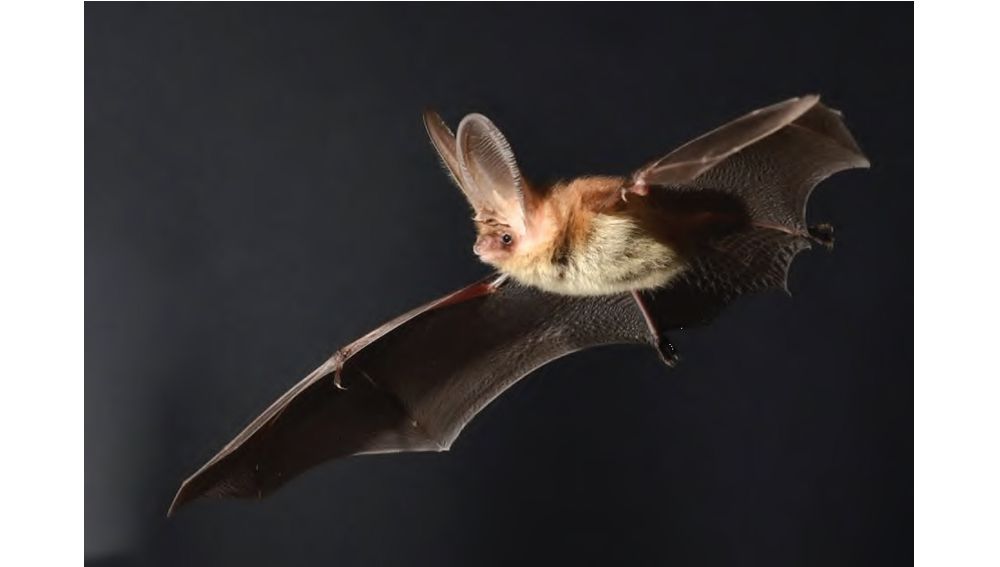BATS
193 Among the inhabitants of the night, bats are the most mysterious and enigmatic, and few people know their true appearance. Usually you can hear a squeak or see a quickly flashing dark shadow. Most people imagine these small animals as some kind of sinister and dangerous creatures. In Turkmenistan, there are 22 species of bats or Chiroptera (this is a name of one of the orders of mammals), and in total there are about 1000 species in the world. These creatures fly well thanks to a leathery membrane connecting the fingers of the forelimbs, the front and hind limbs, and the tail. High flight maneuverability and successful catching of prey are due to the presence of a welldeveloped echolocation system. The signal emitted by the animal, reflected from the surface or insect, is caught by sensitive mobile ears.
The size of the bats living in our country is small – with folded wings, they fit in the palm of yourhand . Despite their smallsize , the animals selflessly defend their freedom.
Many species are characterized by a certain type of sound. It can be a short high squeak, chirring, peeping, and sometimes such a high sound that the human ear cannot catch. Scientists have already invented a device that can determine the species of bat by sound. The shelters of these animals are varied. Some absolutely need a cool microclimate, and for this they actively use caves. For others, some niche, crevice or crack in a rock or cliff, a tree hollow is enough. Some species adapt to living in human buildings. Thanks to various ancient and modern buildings and structures that serve as shelters, bats even master the desert. Some species lead a solitary lifestyle, while others form colonies of varying sizes from small groups to clusters of thousands. Bats typically hibernate, but in our conditions during warming
periods they can interrupt hibernation and hunt for awakened insects. Usually active at dusk and at night, sometimes they can fly during the day. Bats feed on various insects – beetles, butterflies, mosquitoes, midges, grasshoppers, dragonflies, cicadas and others.
The speed of catching prey is amazing – up to 500 – 600 insects per hour. The mass of food eaten reaches 35–40 percent of the bat’s weight. They drink water on the fly from the surface of various bodies of water. Bats reproduce once a year. In different species, the gestation period for young varies between two and three months. Bats typically give birth to 1–2 young, but in some species, scientists have noted the development of 3 embryos. In some species, newborn babies attach themselves to their mothers, and the mothers carry them on themselves for the first time, and later the babies remain in the shelter while the mother flies off to hunt. In other species, the babies are immediately separated from their mothers. Like all mammals, bats feed their babies with milk. At the age of two months, the young animals begin to make their first hunting flights. The horseshoe-nosed bat species are very sensitive creatures and do not tolerate heat and dryness at all, they die quickly. With the help of ringing and keeping in captivity, scientists have found out that bats live a relatively long time. They usually live 10–20 years, but some can live up to 30 and even 40. Birds of prey or owls, as well as diseases, can cut their lives short. Some babies die because they cannot hold on to the ceiling or wall of the shelter and fall down. Bats die if they eat poisoned insects. Sometimes people kill them and destroy their shelters.
Five species of bats are listed in the fourth edition of the Red Data Book of Turkmenistan. It does not take much effort to preserve them, but the bats themselves help people. If bats become your neighbours, there will be fewer mosquitoes, and pests – in the vegetable garden and orchard. When visiting caves, remember the small inhabitants who settled in them long before humans. Bats have been using many caves for centuries, as a result of which huge deposits of their droppings accumulate at the bottom. Some bat species can easily get into their shelters even through a small hole, crawling. But some species (horseshoenosed bats) are not able to crawl, they need a wide entrance to fly into the cave. If people block the entrance to the cave, this disrupts air circulation, selfregulation of humidity and temperature and is an obstacle to the use of the cave by flying animals. Frequent visits to caves by tourists also have an adverse effect on the number of animals. Due to the increasing disturbance factor, bats leave their usual shelter and are forced to look for another, which is not always as good as the previous one. And this can lead to the death of adults and their offspring.
Evgeny Agryzkov, Amudarya State Nature Reserve







